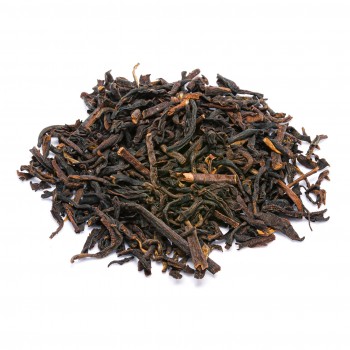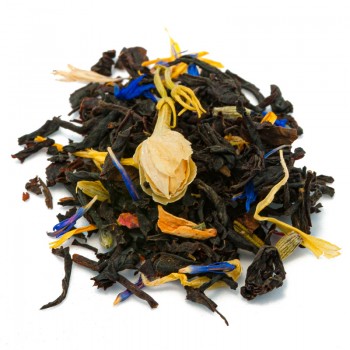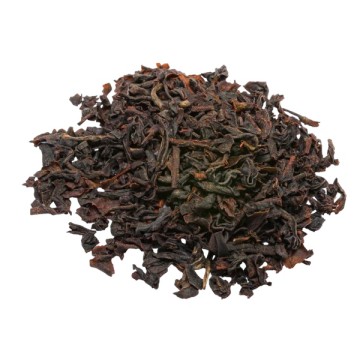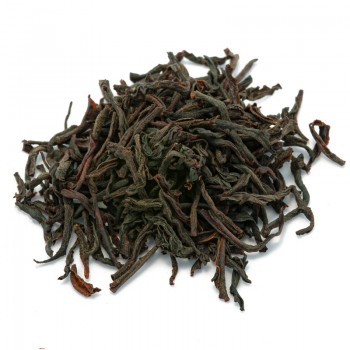It comes from a tea plant of predominantly Chinese origin, but transplanted to the African mountains, in an equatorial region. Kenya Kaproret is a GFOP (Golden Flowery Orange Pekoe) black tea that immediately demonstrates the benefits of this blend. The leaves produce a lively infusion, with an intense flavor, slightly floral-fruity, like its aroma. It is a tea that visually displays leaves with golden tips, and a bright, dark copper color when infused. Its malty note is perfect with a dash of milk, any time of day. Whether for breakfast or to unwind in the evening, a cup of Kenyan tea becomes comforting with every sip.
What are the properties of Kenyan Kaproret black tea?
This tea originates from a plot of land approximately 2,000 meters above sea level, which benefits from clay-rich soil with a high mineral content. This is one of the benefits of this black tea, which can therefore provide our body with its nutrients. In fact, black tea is typically rich in minerals such as magnesium and potassium.
Drinking black tea can benefit well-being, especially due to its antioxidant polyphenol content, which gives it properties that help fight free radicals—substances that are potentially harmful to our cells and promote aging. The astringent tannins and active polyphenols in black tea, such as theaflavin, may benefit gut health.
These natural compounds promote proper digestion and promote gut health by supporting the growth of healthy gut bacteria. Furthermore, the draining and diuretic properties of black tea help combat water retention and bloating.
The polyphenolic compounds in black tea also aid in weight management by facilitating fat oxidation, while caffeine boosts metabolism.
Incorporating black tea into a balanced diet, combined with physical activity, can promote healthy weight loss. Furthermore, the full-bodied flavor of black tea helps maintain a sense of satiety, thus reducing appetite. Although black tea contains less caffeine than coffee, it is still an energizing drink that can be consumed for a boost of energy, increased attention span, and concentration. It stimulates our nervous system in a way that is not overly exciting and immediate like coffee; Its long-lasting and balanced effect is due to the simultaneous presence of caffeine and the amino acid L-theanine in black tea.
Nutritional Values of Black Tea
Kenyan Kaproret tea infusion contains minerals such as iron, magnesium, phosphorus, potassium, sodium, and zinc. It also provides B vitamins, enzymes, tannins, and amino acids, including L-theanine. It provides the body with methylxanthines, alkaloids that include caffeine (theine) and theophylline.
How to prepare a Kaproret black tea infusion
In a cup (250 ml), place about 3-5 grams of tea in a filter or tea bag. Pour boiling water at a temperature of 90-95°C and cover the cup with a lid. Simply steep Kaproret black tea for 3 to 5 minutes to obtain a delicious, aromatic, amber-colored cup.
Where to buy Kaproret black tea?
Natura d'Oriente offers loose leaf tea online, including the Kenyan tea variety. You can find this loose Kaproret tea in convenient 25g, 50g, 75g, 100g, 150g, and 300g packs at a great price.
Where does Kaproret black tea come from?
It is grown and produced in Kenya in the Kericho district, in the western part of the country, east of Lake Victoria and near the spectacular Mau Forest (South Western Mau National Reserve). It is grown in tea gardens scattered across the Kericho highlands, such as Kaproret, Saramek, and Chemase, at an altitude of over 2,000 meters. This area is perfect for growing plants year-round thanks to its equatorial location, high altitude that tempers the scorching heat, and abundant rainfall.
It comes from hybrid shrubs of Camellia sinensis sinensis, the Chinese variety of the tea plant, transplanted to these African lands. For this reason, Kaproret tea leaves are often confused with those of Chinese black teas from Yunnan. The leaves undergo the classic oxidation process for black teas, becoming a GFOP (Golden Flowery Orange Pekoe) black tea. This is a quality tea obtained from the bud and the first two leaves of the tea (very fine leaves and buds). This harvest includes a high proportion of golden buds, which are the tips of the yellow-golden shoots. Kenya Kaproret is therefore derived from tender, young leaves, which can be from the first harvest, usually from January to March, or from the second in June and July.
Tea grown in Kenya is third in the world after China andIndia is the world's largest producer, and this agricultural tradition dates back only to the late 19th century, when the first plantation was established in Malawi. The practice of tea dates back to the time when Portuguese and Dutch explorers introduced tea to Africa, but it wasn't until the 20th century that cultivation took hold in Kenyan territories. In 1903, a decorative plantation was inaugurated in Limuru by the British explorer G.W. I. Caine, followed by other commercial plantations spread throughout what is now the Republic of Kenya.

![Black tea Kaproret GFOP [Natura d'Oriente] Black tea Kaproret GFOP [Natura d'Oriente]](https://www.naturadoriente.com/3387-large_default/kaproret-black-tea-gfop.jpg)




![Black tea Kaproret GFOP [Natura d'Oriente] Black tea Kaproret GFOP [Natura d'Oriente]](https://www.naturadoriente.com/3387-home_default/kaproret-black-tea-gfop.jpg)




 No reward points for this product.
No reward points for this product.















